EnTT
Introduction
EnTT is the data-oriented entity component system (ECS) used by Minecraft: Bedrock Edition. It is used to store common data for entities, such as position and collision boxes, in discrete structs referred to as components.
With each version release, more pieces of Actor data are moved from class members to dedicated components; fortunately, EnTT makes it possible to respond quickly to these changes and maintain up-to-date Minecraft version compatibility.
For more information on EnTT, check out the highly informative and comprehensive wiki written by its maintainer.
Picking the Version
The specific version of EnTT that is required for your Minecraft version will vary:
| MC:BE Release | EnTT Tag | EnTT Commit Hash |
|---|---|---|
1.21.90+ | N/A | fe8d7d78c4823e8a66a050bf86f5c6318cf76ce7 |
1.21.60-1.21.8x | N/A | 8e6bbc4a6c7182a0d8c1c9b46ebe5858585e12d9 |
1.21.0-1.21.5x | N/A | f931687ff04d435871ac9664bb299f71f2a8fafc |
1.20.70-1.20.8x | v3.13.1 | 2909e7ab1f1e73a36f778319070695611e3fa47b |
1.20.50-1.20.6x | N/A | 62a13526c989f14eff348c28c061542ac7a16d45 |
1.20.4x | N/A | 717897052477515260bde3fd21fe987662666621 |
Including EnTT
This guide only addresses including EnTT for CMake based projects.
The CMake FetchContent module can be used to download and include EnTT's CMake project from a git commit hash or tag:
include(FetchContent)
FetchContent_Declare(
EnTT
GIT_REPOSITORY https://github.com/skypjack/entt.git
GIT_TAG 2909e7ab1f1e73a36f778319070695611e3fa47b # v3.13.1
)
FetchContent_MakeAvailable(EnTT)
target_link_libraries(MyTarget PRIVATE EnTT::EnTT)Alternatively, if a package repository is configured in your environment, find_package can be used as a less verbose option. However, only official releases that are published to the repository will be available, not necessarily specific commits.
find_package(EnTT 3.13.1 CONFIG REQUIRED)
target_link_libraries(MyTarget PRIVATE EnTT::EnTT)Configuration
Mojang has configured EnTT in multiple ways to suit the needs of Minecraft: Bedrock Edition. In order for your mod to have binary compatibility with Minecraft and avoid runtime errors, the configuration of EnTT must match exactly.
The first step is to define a custom entity identifier type:
struct EntityId {
std::uint32_t rawId;
[[nodiscard]] constexpr bool operator==(const EntityId& other) const = default;
[[nodiscard]] constexpr operator std::uint32_t() const {
return this->rawId;
}
};In order to use the custom identifier type with EnTT, an entt::entt_traits specialization must be defined (All the numeric values below are specific to Mojang's specialization of EnTT and were extracted through reverse engineering):
struct EntityIdTraits {
using value_type = EntityId;
using entity_type = std::uint32_t;
using version_type = std::uint16_t;
static constexpr entity_type entity_mask = 0x3FFFF; // lower 18 bits of raw id
static constexpr entity_type version_mask = 0x3FFF; // upper 14 bits of raw id
};template<>
struct entt::entt_traits<EntityId> : entt::basic_entt_traits<EntityIdTraits> {
static constexpr std::size_t page_size = 2048;
};Next, component storage must be configured. The method demonstrated below is done by creating a base class that all components will be derived from, and then specializing entt::component_traits for derivatives of that base class.
struct IEntityComponent {};
template<std::derived_from<IEntityComponent> Type>
struct entt::component_traits<Type, EntityId> {
using element_type = Type;
using entity_type = EntityId;
static constexpr bool in_place_delete = true;
static constexpr std::size_t page_size = 128 * !std::is_empty_v<Type>;
};struct IEntityComponent {};
template<std::derived_from<IEntityComponent> Type>
struct entt::component_traits<Type> {
using type = Type;
static constexpr bool in_place_delete = true;
static constexpr std::size_t page_size = 128 * !std::is_empty_v<Type>;
};Lastly, signal handlers must be disabled for EntityId derived storage types, this is done by specializing entt::storage_type, and not wrapping entt::basic_storage in entt::sigh_mixin (like the default specialization does).
template<typename Type>
struct entt::storage_type<Type, EntityId> {
using type = basic_storage<Type, EntityId>;
};Now you have a properly configured environment for EnTT which is ABI compatible with Minecraft: Bedrock Edition.
IMPORTANT
All usages of EnTT within your code need to have visibility to the specializations that are provided above. An easy way of guaranteeing this is to put the specializations in the same header that is defining EntityId, as everything else will be dependent upon it.
Defining Components
When defining components, there are a few key things that must be matched to the game:
- The type name
- The type's class/struct designation
- The type size
- The type's hash
Matching the Declaration
Component names and their and class/struct designation are simple enough to find. EnTT leaves strings in all Minecraft: Bedrock Edition binaries as part of type name stored in the static entt::type_info<T> instance for all components; however, only Windows binaries compiled with MSVC will include the class/struct designation:
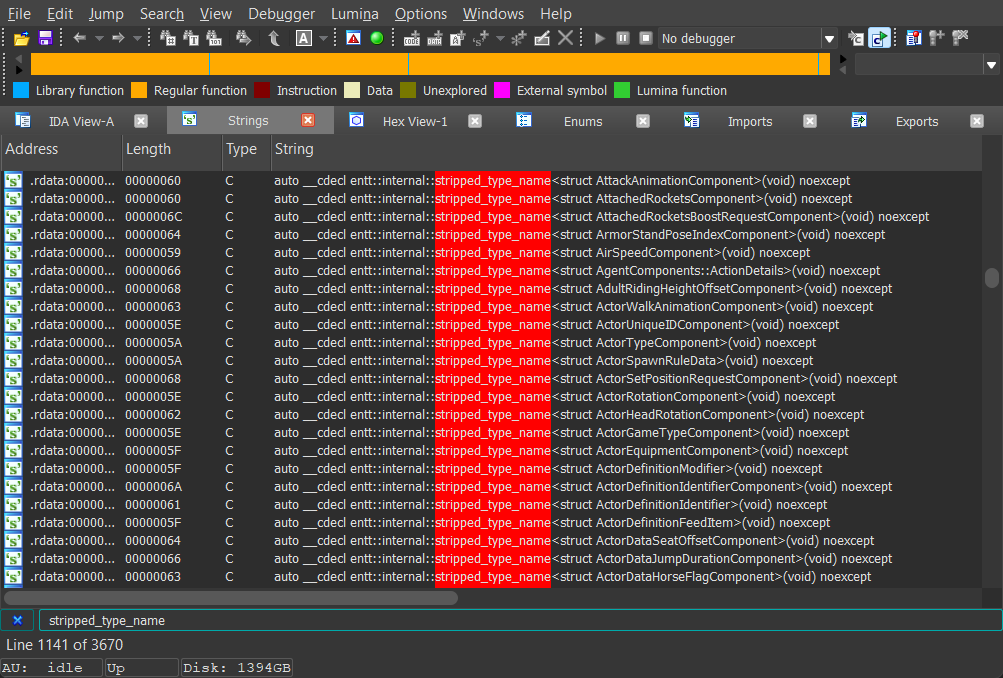
TIP
The majority of entity components are struct types. A few notable class exceptions are ActorOwnerComponent and FlagComponent.
We'll be taking a look at ActorEquipmentComponent for this guide. Looking back at the screenshot with all the type names, we can begin a definition:
struct ActorEquipmentComponent : IEntityComponent {};Finding the Size
There are multiple methods for finding the size of a component through IDA. The exact method used will be dependent on the component, but the easiest way is finding the codegen for entt::basic_registry<EntityId>::try_get<T>(EntityId).
Sometimes, try_get<T> will get completely inlined into Actor::tryGetComponent<T>:
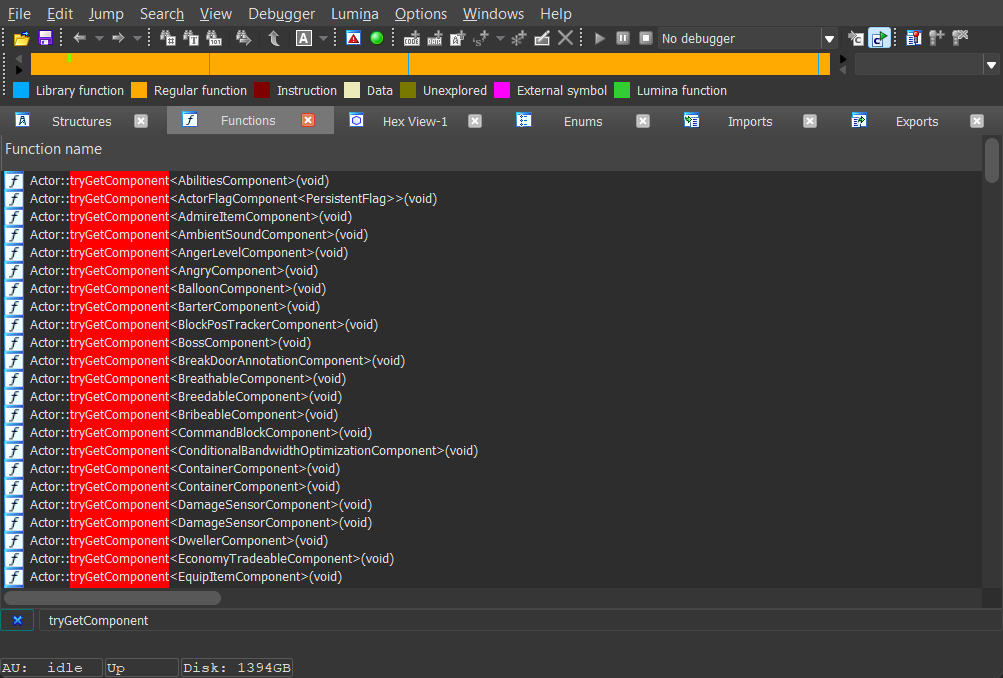
Other times, the actual try_get<T> function will be available:
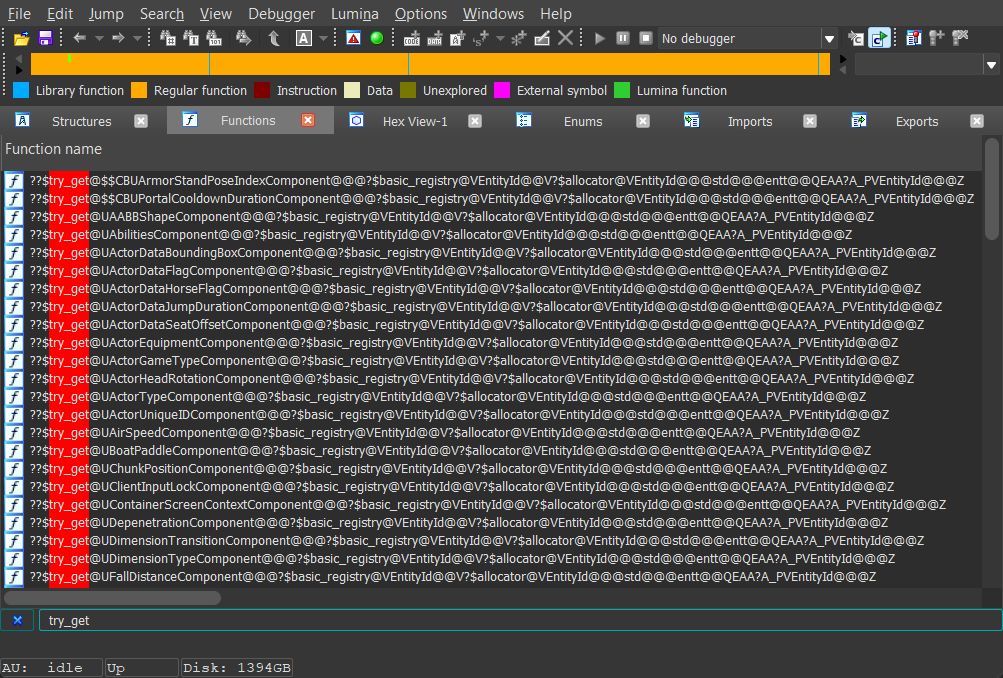
If either of these are available, the size is immediately available when decompiling the function into pseudocode. For ActorEquipmentComponent, that's 16 (0x10) bytes:
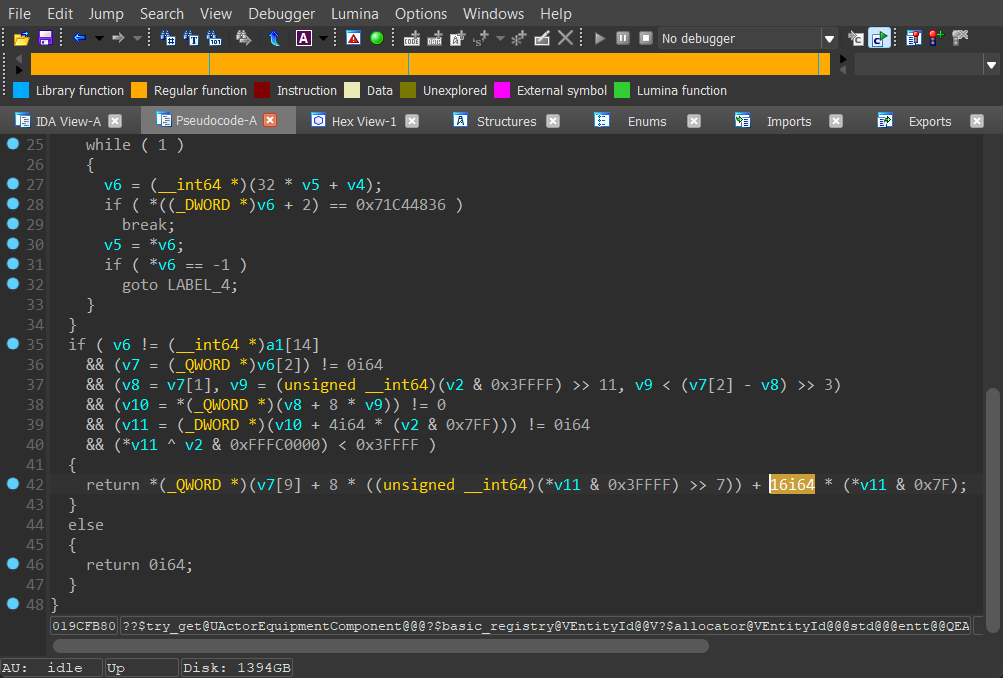
This simple approach does not work for all components, as it is reliant on the compiler not inlining the try_get implementation. Fortunately, there does exist a foolproof solution: a entt::basic_storage<T, EntityId> virtual function table is created for every component.
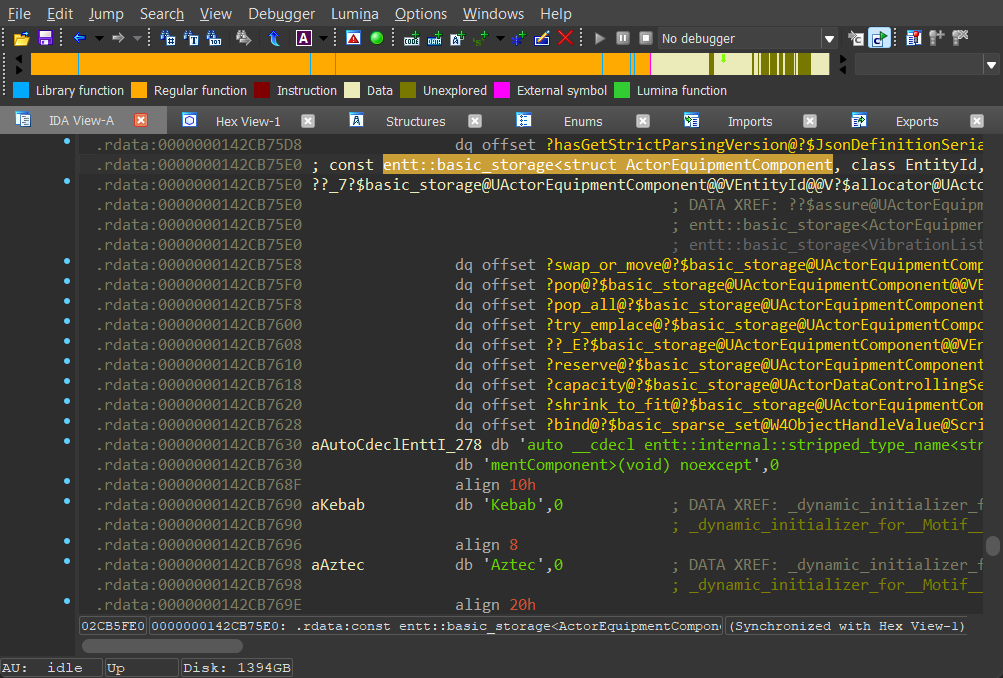
By following the function calls from entt::basic_storage<T, EntityId>::try_emplace, we can end up at the size of the component in plain view in the pseudocode:
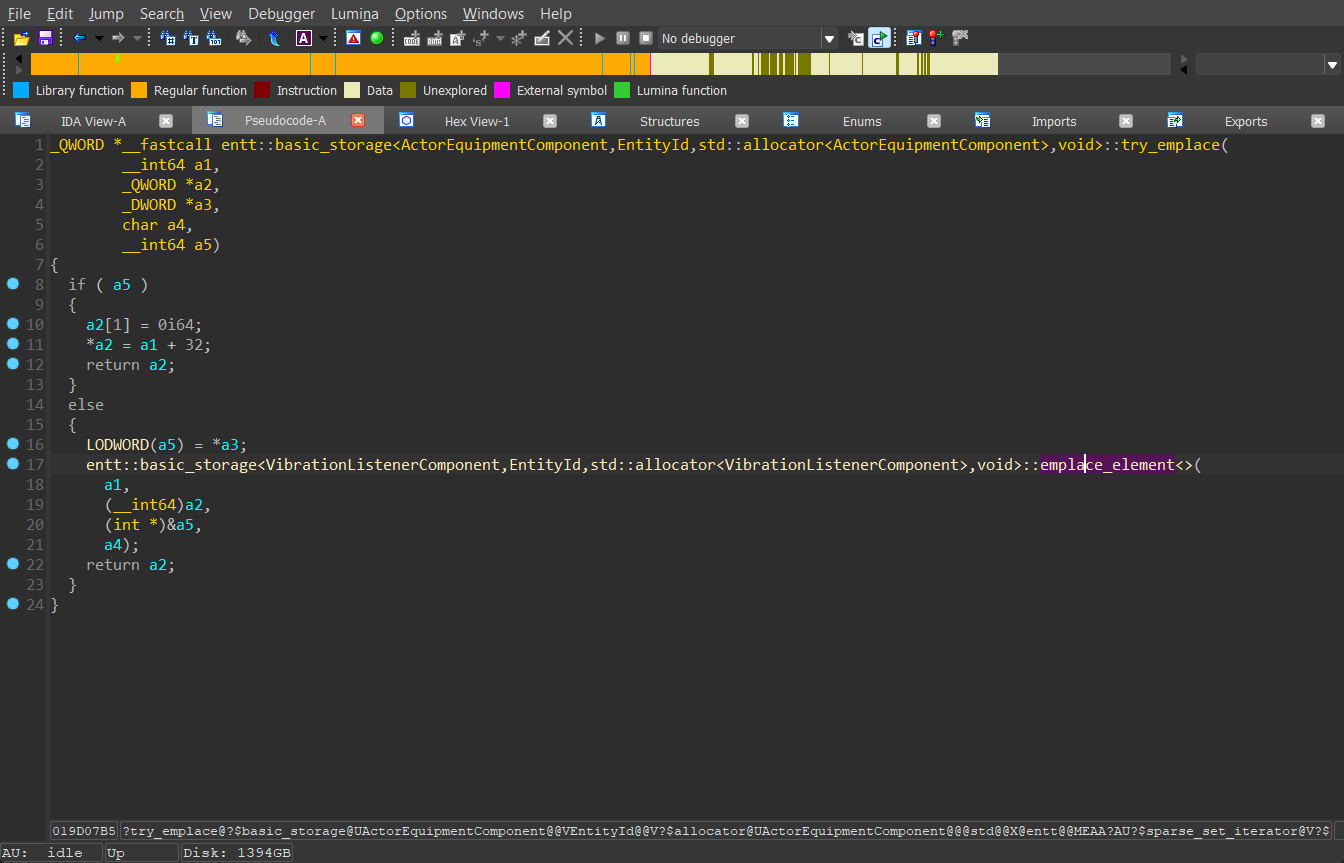
Then to entt::basic_storage<T, EntityId>::emplace_element:
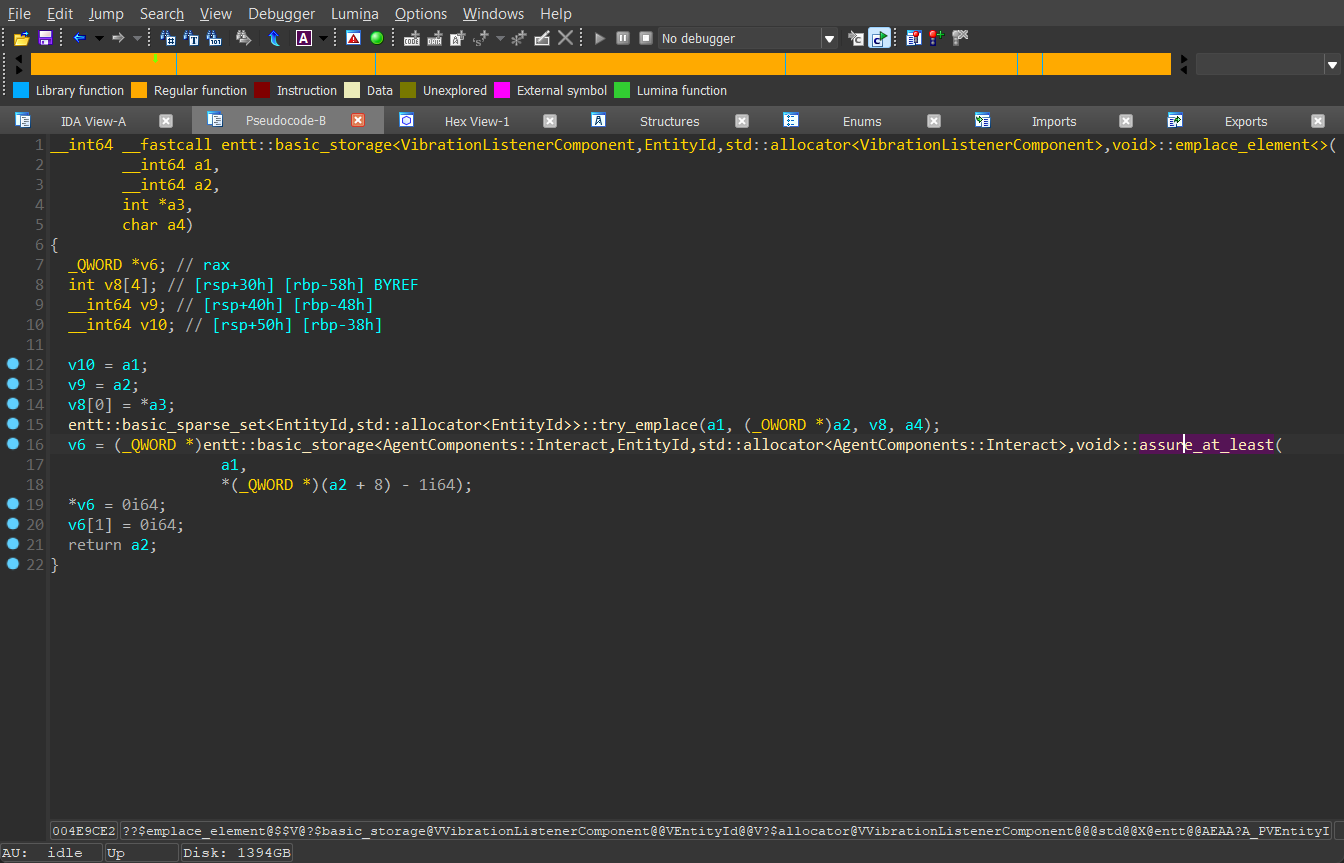
And finally entt::basic_storage<T, EntityId>::assure_at_least:
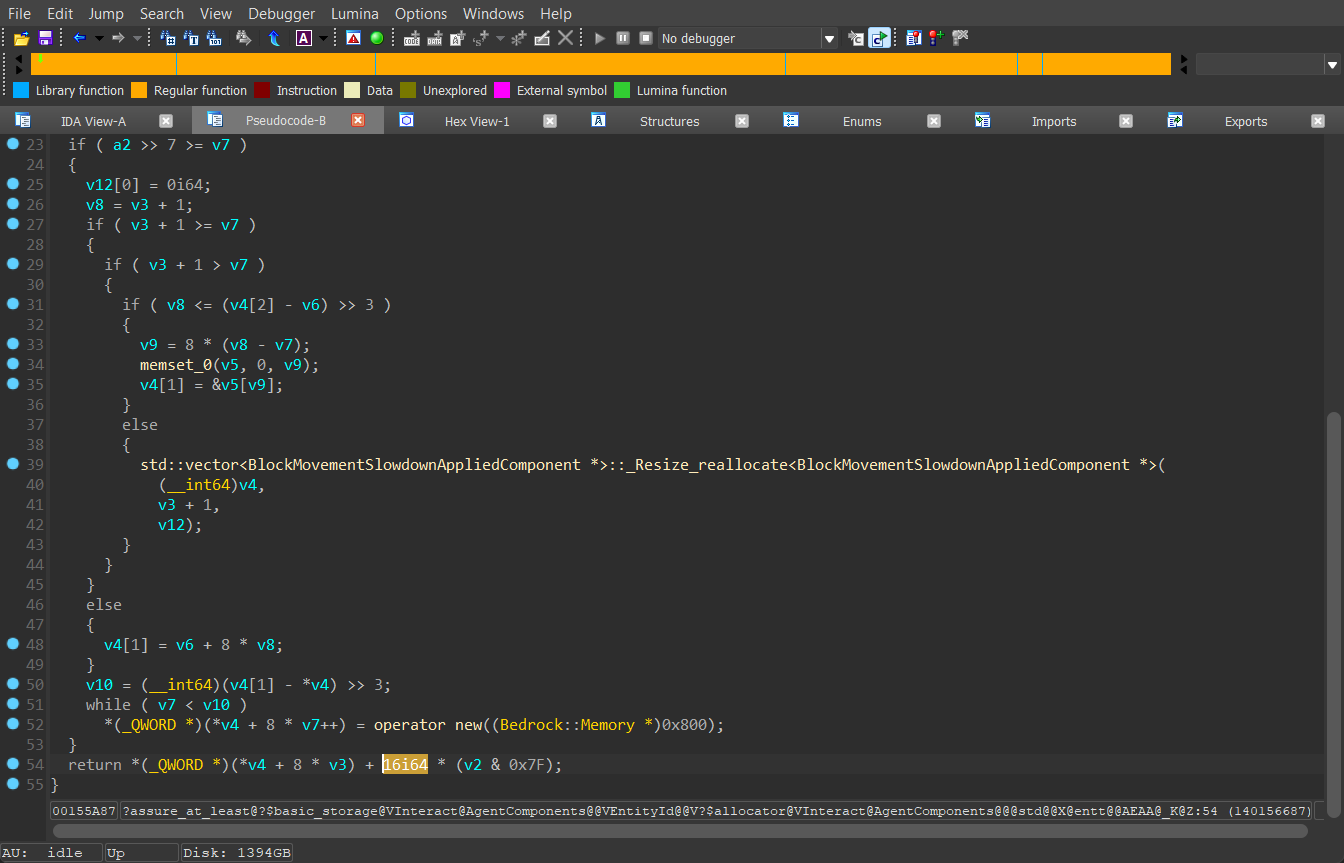
The component's size can be identified in the same manner as before by looking at the scale applied to the (vN & 0x7F) term. This matches the previous result of 16 bytes.
Reversing Members
Now that we have the size of the component, we can pad the definition like this:
struct ActorEquipmentComponent : IEntityComponent {
std::byte pad[0x10];
};
static_assert(sizeof(ActorEquipmentComponent) == 0x10);TIP
Using a static_assert to validate the known size of a component can turn potential runtime errors into compile time errors.
The next logical step is to find out what those 16 bytes are actually comprised of. Depending on the component, this can be extremely tedious, but a solid starting point is to examine the try_get usages.

The first usage provides some insight, line 14 in the decompiled pseudocode contains a virtual function call being performed on an object whose address is stored at offset 8 in the component.
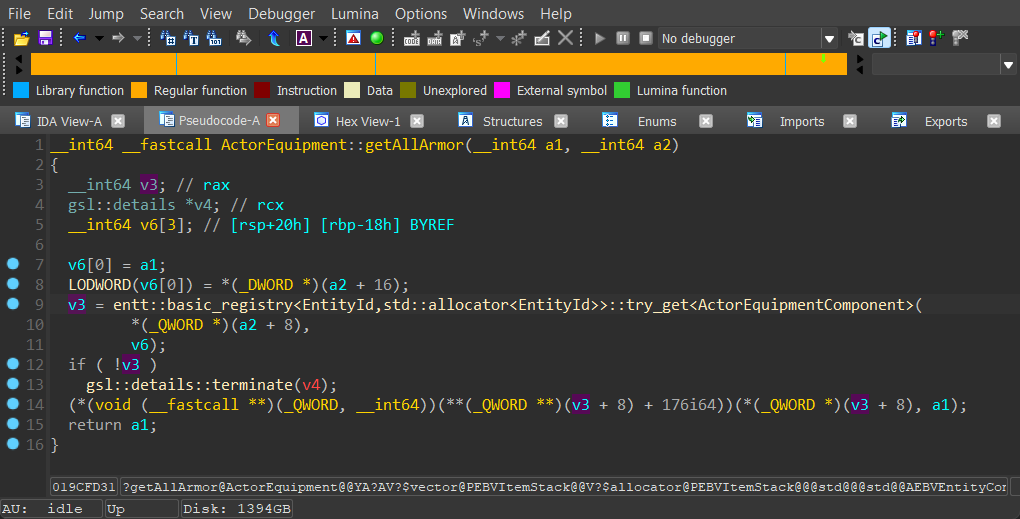
Let's update the struct according to our finding:
struct ActorEquipmentComponent : IEntityComponent {
std::byte pad[0x8];
void* ptrToUnknownVirtualType;
};The next usage provides a bit more insight, it tells us that the unknown virtual type is actually SimpleContainer:
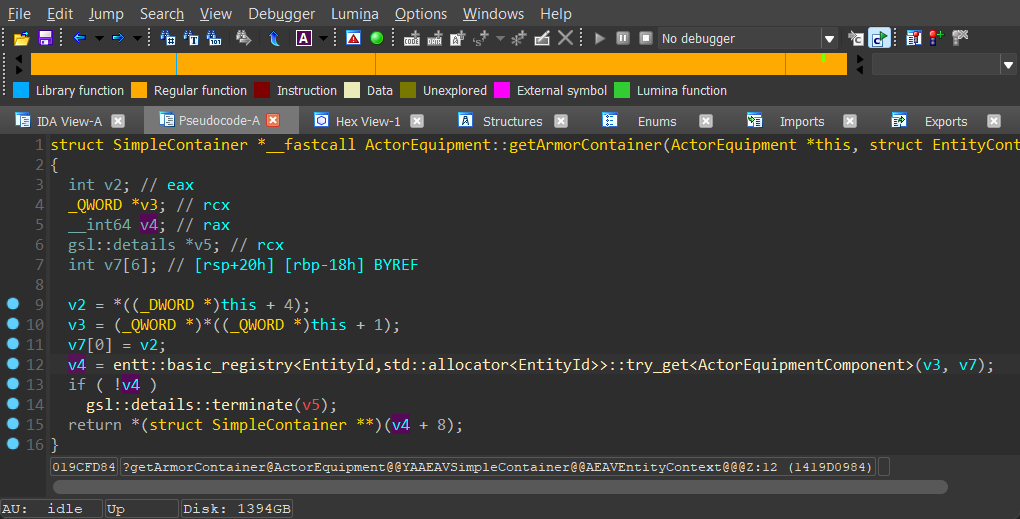
struct ActorEquipmentComponent : IEntityComponent {
std::byte pad[0x8];
SimpleContainer* armorContainer;
};And the next usage confirms the same about the data stored at offset 0 in the component: it's another pointer to a SimpleContainer:
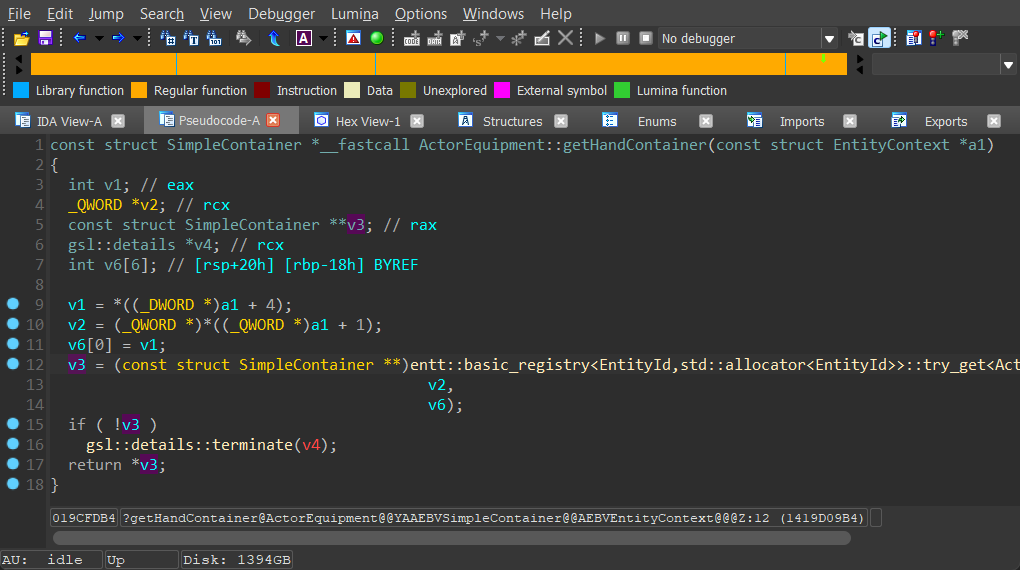
struct ActorEquipmentComponent : IEntityComponent {
SimpleContainer* handContainer;
SimpleContainer* armorContainer;
};So is that it? Well, not necessarily. Entity components are intended to be owning types (they are responsible for the lifetimes of their members) and a raw pointer does not indicate anything in regard to ownership. Additionally, legitimate raw pointers are uncommon in Minecraft: Bedrock Edition.
TIP
Looking at how an object is destroyed provides direct insight into the ownership model of its data members.
Referencing back to the entt::basic_storage<T, EntityId> vtable from earlier, we can take a look at the pop_all virtual member function to see how the component is destroyed:
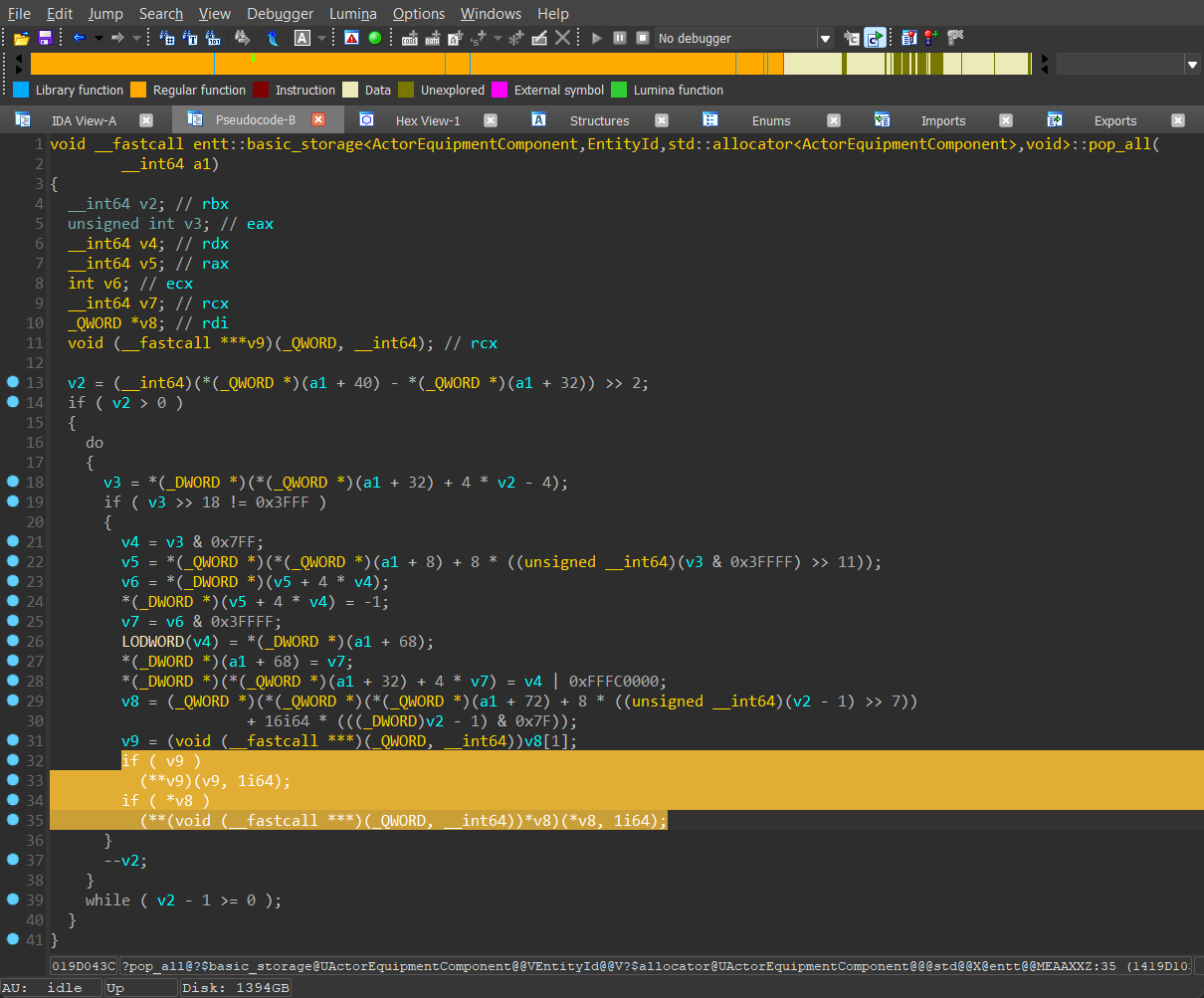
If you're unfamiliar with reverse engineering Windows C++ applications compiled against the Microsoft STL, this might not seem significant. However, it's actually indicative of a std::unique_ptr to a virtual type (For more on this, continue reading).
With this information, the definition for ActorEquipmentComponent can be completed:
struct ActorEquipmentComponent : IEntityComponent {
std::unique_ptr<SimpleContainer> handContainer;
std::unique_ptr<SimpleContainer> armorContainer;
};Type Hashes
NOTE
If you are using the compiler associated with your mod's targeted Minecraft: Bedrock Edition platform, the information provided in this section is not critical.
For more on what compiler you should be using, continue reading.
The entt::registry creates a storage object for each component type. In order to retrieve the storage instance at runtime, a hash of the component's type is used as a key into a map<type_hash, component_storage>. While the hash of a type is based on the prettified name of that type, it is not portable. Consider the following example:
template<typename T>
class FlagComponent : IEntityComponent {};
struct OnGroundFlag {};| Compiler | entt::type_name<T>::value() | entt::type_hash<T>::value() |
|---|---|---|
| MSVC | "class FlagComponent<struct OnGroundFlag>" | 0x211F2DE1 |
| GCC/Clang | "FlagComponent<OnGroundFlag>" | 0x062EEC98 |
This discrepancy is not an issue if you're using the recommended compiler for a given Bedrock platform. However, if you are using Clang on Windows, it does become an issue. Clang will produce the same type hash regardless of whether you are using it in Microsoft compatibility mode. To work around this problem, we can specialize entt::type_hash.
There are many approaches to specializing entt::type_hash to maintain compatibility between compilers. This guide will specifically address a solution for using Clang on Windows when developing mods for Bedrock Edition on Windows.
Building upon the previous example, let's add a few static members to our classes. For this, we'll be using fixed_string provided by libhat:
template<typename T>
class FlagComponent : IEntityComponent {
public:
static constexpr hat::fixed_string type_name
= "class FlagComponent<" + T::type_name + ">";
};
struct OnGroundFlag {
static constexpr hat::fixed_string type_name
= "struct OnGroundFlag";
};Then create a entt::type_hash specialization for types derived from IEntityComponent:
template<std::derived_from<IEntityComponent> Type>
struct entt::type_hash<Type> {
[[nodiscard]] static consteval id_type value() noexcept {
constexpr auto name = Type::type_name;
return hashed_string::value(name.data(), name.size());
}
[[nodiscard]] consteval operator id_type() const noexcept {
return value();
}
};Using Components
EntityContext
Minecraft's EntityContext class encapsulates the required state for accessing an entity's components.
struct EntityRegistry : std::enable_shared_from_this<EntityRegistry> {
std::string name;
entt::basic_registry<EntityId> registry;
uint32_t id;
};
struct EntityContext {
EntityRegistry& registry;
entt::basic_registry<EntityId>& enttRegistry;
EntityId entity;
};struct EntityRegistryBase {
entt::basic_registry<EntityId>& registry;
uint32_t id;
};
struct EntityRegistry : EntityRegistryBase, std::enable_shared_from_this<EntityRegistry> {
std::string name;
entt::basic_registry<EntityId> ownedRegistry;
};
struct EntityContextBase {
EntityRegistryBase& registry;
EntityId entity;
};
struct EntityContext : EntityContextBase {
entt::basic_registry<EntityId>& getEnttRegistry() const {
return static_cast<EntityRegistry&>(this->registry).ownedRegistry;
}
};NOTE
For simplicity, these game classes are expressed as structs to imply public visibility. The actual type designation and member visibility may vary from Minecraft's actual source code.
Samples from this point on will be based on the most recent revision of the relevant Minecraft ABI (Currently 1.20.50+). If you are developing for a different Minecraft release, slight modifications may be required.
We can define a few helper functions for accessing and modifying components:
struct EntityContext {
// ... fields omitted ...
template<std::derived_from<IEntityComponent> T>
[[nodiscard]] T* tryGetComponent() {
return this->enttRegistry.try_get<T>(this->entity);
}
template<std::derived_from<IEntityComponent> T>
[[nodiscard]] const T* tryGetComponent() const {
return this->enttRegistry.try_get<T>(this->entity);
}
template<std::derived_from<IEntityComponent> T>
[[nodiscard]] bool hasComponent() const {
return this->enttRegistry.all_of<T>(this->entity);
}
template<std::derived_from<IEntityComponent> T>
T& getOrAddComponent() {
return this->enttRegistry.get_or_emplace<T>(this->entity);
}
template<std::derived_from<IEntityComponent> T>
void removeComponent() {
this->enttRegistry.remove<T>(this->entity);
}
};WARNING
Both getOrAddComponent and removeComponent call the non-const version of entt::basic_registry<...>::assure<T>. If either of these functions are called before storage for the component T has been created by Minecraft, the storage will be created by your mod. The undesired consequence of this is that the storage object's virtual function table will be located in the read-only data section of your mod's binary. Unloading the mod after this point will cause a game crash. While there are methods to prevent this error, this guide does not currently address them.
Actors
Now that we have a definition of EntityContext, we need to be able to access an instance of it for Actors. Fortunately, this is an easy task:
class Actor {
public:
/* this + 0x0 */ Actor_vtbl* __vftable; // Compiler generated
/* this + 0x8 */ EntityContext entity;
// ... fields omitted ...
};If defining the actual struct for Actor isn't preferred, libhat provides hat::member_at, a utility function for accessing members from class data offsets.
class Actor {
public:
// Utilize C++23's explicit this object parameter
// to avoid writing const and non-const overloads
[[nodiscard]] auto& getEntity(this auto& self) {
return hat::member_at<EntityContext>(&self, 0x8);
}
};Now if we obtain an instance of an Actor, such as the client's local player, accessing components is simple:
void onLevelTick() {
auto& player = clientInstance->getLocalPlayer().getEntity();
if (player.hasComponent<FlagComponent<OnGroundFlag>>()) {
logToChat("Player is on the ground");
}
if (auto* svc = player.tryGetComponent<StateVectorComponent>(); svc) {
logToChat("Player is at {}", svc->pos);
}
}